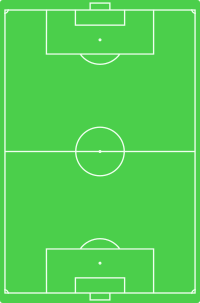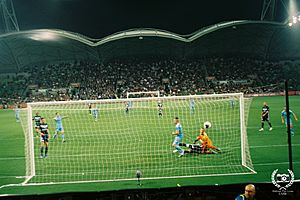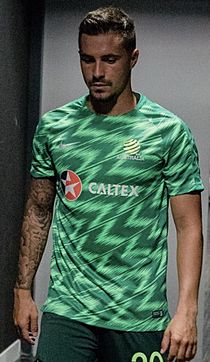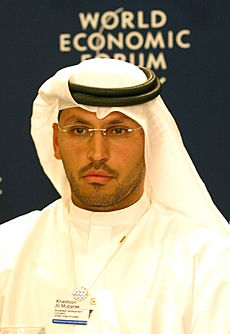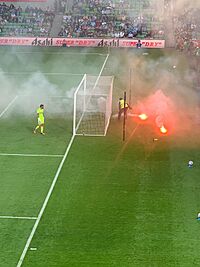Melbourne City FC facts for kids
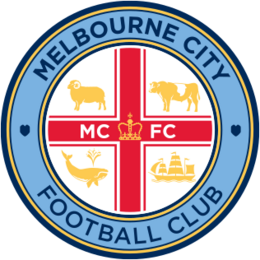 |
||||
| Full name | Melbourne City Football Club | |||
|---|---|---|---|---|
| Nickname(s) | City, Hearts, Heart, City Boys, City Blues | |||
| Founded | 12 June 2009 (as Melbourne Heart) | |||
| Ground | Melbourne Rectangular Stadium | |||
| Capacity | 30,050 | |||
| Owner | City Football Group | |||
| Chairman | Khaldoon Al Mubarak | |||
| Head coach | Aurelio Vidmar | |||
| League | A-League Men | |||
| 2022–23 | 1st of 12 (premiers) | |||
|
||||
Bold indicates the club was founded by CFG.
* indicates the club was acquired by CFG.
§ indicates the club is co-owned.
| 2008 | Manchester City F.C.* |
|---|---|
| 2009 | |
| 2010 | |
| 2011 | |
| 2012 | |
| 2013 | New York City FC§ |
| 2014 | Melbourne City FC* |
| Yokohama F. Marinos*§ | |
| 2015 | |
| 2016 | |
| 2017 | Montevideo City Torque* |
| Girona FC*§ | |
| 2018 | |
| 2019 | Sichuan Jiuniu F.C.*§ |
| Mumbai City FC*§ | |
| 2020 | Lommel S.K.* |
| ES Troyes AC* | |
| 2021 | |
| 2022 | Palermo F.C.*§ |
Melbourne City Football Club is a professional soccer team from Melbourne, Australia. They play in the A-League Men, which is the top soccer league in Australia. The club is part of the City Football Group, a company that owns several soccer clubs around the world.
The club started in 2009 as Melbourne Heart. They played under this name until the 2013–14 season. In January 2014, the City Football Group bought the club. It was then renamed Melbourne City. In August 2015, City Football Group became the full owner.
Since they began, Melbourne City has won three A-League Men premierships. They have also won two championships and one Australia Cup in 2016.
Melbourne City trains at the City Football Academy in Cranbourne East. Their home games are played at Melbourne Rectangular Stadium, also known as AAMI Park. This stadium can hold 30,050 fans.
Melbourne City also has a youth team and a women's team. The youth team plays in the Victorian Premier League 1. The women's team, called Melbourne City Women, competes in the A-League Women.
Contents
- Club History: From Heart to City
- Club Identity: Name, Colours, and Badge
- Club Sponsors
- Home Ground: Melbourne Rectangular Stadium
- Club Records and Statistics
- Players and Staff
- Club Achievements
- AFC Club Ranking
- Continental Competitions
- Melbourne City Women's Team
- Club Facilities
- Club Rivalries: The Melbourne Derby
- More About Melbourne City
- See also
Club History: From Heart to City
Starting as Melbourne Heart (2009–2014)
After Australia's first national soccer league ended in 2003, a new league called the A-League was planned. In 2004, Football Federation Australia (FFA) decided that Melbourne Victory would be the only team from Melbourne in the new league. They wanted "one city, one team" for the first five seasons.
However, in 2008, people started talking about a second Melbourne team. Two groups, 'Melbourne City' and 'Melbourne Heart', wanted to join the league. The 'Melbourne Heart' group won the right to negotiate. On June 12, 2009, they were given a license to join the A-League for the 2010–11 season.
Melbourne Heart played their first game on August 5, 2010, at AAMI Park. They lost 1–0 to Central Coast Mariners. Their first goal was an own goal by an opponent. Their first win was 1–0 against North Queensland Fury. On October 8, 2010, they played their first ever Melbourne Derby against Melbourne Victory and won 2–1. Heart finished their first season in eighth place.
In their second season, Melbourne Heart finished 6th and made it to the finals. They lost their first finals game 3–0 to Perth Glory. Over the next two seasons, they continued to win against their local rivals. However, they finished near the bottom of the league, even getting the "wooden spoon" (last place) in 2013–14.
Becoming Melbourne City and Winning the FFA Cup (2014–2019)
On January 23, 2014, the City Football Group bought Melbourne Heart. They bought 80% of the club for $12 million. The other 20% was owned by a group of businessmen. On June 5, 2014, the team changed its name to Melbourne City FC.
To help the new team, Spanish World Cup winner David Villa joined on loan. He was supposed to play ten games but only played four. Even so, his presence helped bring a lot of attention to the club. In 2015, City Football Group bought the remaining 20% of the club, becoming its full owner.
Under coach John van 't Schip, the team became known for exciting, high-scoring soccer. The 2015–16 season was very successful. Striker Bruno Fornaroli helped the team score many goals. The men's team finished fourth in the league. The women's team had an amazing season, winning all 14 of their games and both the premiership and championship.
In November 2016, the men's team won its first trophy, the FFA Cup, by beating Sydney FC 1–0. Despite this, they often lost in the later stages of other knockout competitions. Coach van 't Schip left in the middle of the 2016–17 season.
After van 't Schip left, Warren Joyce became the manager. He improved the team's defense but did not win any trophies. He left at the end of the 2018–19 season. During his time, several important players left the club.
Grand Finals and League Success (2019–Present)
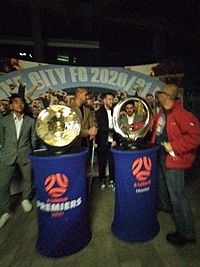
Erick Mombaerts became the new manager for the 2019–20 season. New players like Florin Berenguer, Adrián Luna, Craig Noone, and striker Jamie Maclaren joined the team. City reached their second FFA Cup Final but lost 4–0 to Adelaide United.
The team bounced back and finished the season in second place, their highest ever. Jamie Maclaren won the Golden Boot award for scoring 22 goals. City reached their first ever Grand Final by beating Western United. However, they lost 1–0 to Sydney FC in extra time.
Mombaerts left in September 2020, and his assistant, Patrick Kisnorbo, took over. Under Kisnorbo, City had a record-breaking 2020–21 season. They won the club's first A-League premiership with three games left.
Kisnorbo then led a young City team to win the 2020–21 A-League Championship, beating Sydney FC 3–1. This was a huge achievement for the club. They played in the AFC Champions League for the first time in 2022. They went undefeated but did not make it to the knockout stages.
City won their second premiership in a row in the 2021–22 season. However, they lost to Western United in the grand final. In the 2022–23 season, they won their third premiership in a row. This made them the first club in Australian domestic league history to do so. They lost their fourth grand final to the Central Coast Mariners.
In the 2023–24 season, City finished sixth and were defeated in the elimination final. The club finished the 2024–25 season in second place, qualifying for the 2025–26 AFC Champions League Elite tournament. They reached their fifth grand final in six seasons, beating Western United in the semi-final. In the final, they faced Melbourne Victory and won 1–0, with Yonatan Cohen scoring the winning goal. This secured City's second men's championship.
Club Identity: Name, Colours, and Badge
Naming the Club: Melbourne Heart
|
|
| Melbourne Heart's first home kit |
In 2009, a competition was held to name the new Melbourne team. Some of the ideas were 'Sporting Melbourne FC' and 'Melbourne Heart FC'. The name 'Melbourne Heart FC' was chosen and announced on February 2, 2010.
For their first home kit, Melbourne Heart chose red and white striped jerseys with red shorts and socks. Their away kit was a red sash on a white jersey. They also had a third kit each season, which was designed by fans.
Changing to Melbourne City
When the City Football Group took over in January 2014, there was talk about changing the club's name and colours to sky blue, like Manchester City. The name "Melbourne City Football Club" was registered.
In April 2014, it was reported that Melbourne Heart wanted to change their colours to sky blue. However, Sydney FC complained because sky blue was their main colour. They argued that having two teams in sky blue would be confusing.
In May 2014, it seemed the FFA agreed with Sydney FC. But Melbourne Heart said they were still discussing their future plans, including their kit colours. The club was officially renamed Melbourne City FC on June 5, 2014.
In June 2016, the FFA announced that Melbourne City could fully use "City Blue" colours for their home kit from the 2017–18 season. Sydney FC kept the exclusive right to use "Sky Blue."
Team Kits
Melbourne City's home kit since the 2017–18 season is all "city blue." The shorts and socks are the same colour. For many years, their away kit was red and white striped. This changed to a white zebra-shaped design with black shorts and socks for the 2019–20 season. The red and white striped design is currently the club's Away kit in the 22-23 Season. City also wore an all-black third kit in the 2018–19 season.
Between 2014 and 2016, Melbourne City wore a mostly white home kit with blue stripes. In the 2016–17 season, the home kit was still mostly white but had light blue sleeves and collar.
The away kit during the 2014–15 and 2015–16 seasons used red and white stripes, similar to the old Melbourne Heart kits. This was to remember the club's history and its original colours. The away strip changed to a horizontal white/red design in 2016–17.
Many fans were unsure about the change from Heart to City in 2014, especially losing the red and white colours. However, the club has included red in supporter scarves and away kits to honor its traditional colours.
Club Sponsors
Melbourne City's sponsors often connect with other clubs in the City Football Group. After the takeover, Nike supplied the kits, and Etihad Airways became the main sponsor. Etihad is still a sponsor. In 2019, Puma became the new kit supplier for five years.
Before the City Football Group took over, Melbourne Heart's first sponsor was Westpac, a financial company. Other major sponsors included Drake International and BDO. The club also had a two-year deal with kit supplier Kappa in 2012.
| Period | Kit manufacturer | Front shirt sponsor | Back shirt sponsor | Sleeve sponsor | Front short sponsor | Back short sponsor |
|---|---|---|---|---|---|---|
| 2010–2011 | Reebok | Westpac | PKF | Drake International | Metlink | Solo |
| 2011–2012* | ISC | |||||
| 2012–2013* | Kappa | BDO International | AXF Group (Home)
MatchWorks (Away) |
PTV | Foxtel | |
| 2013–2014* | Alcatel onetouch | Diabetes College | ||||
| 2014 | Nike | Etihad | Hostplus | CoCo Joy (Home)
MatchWorks (Away) |
Westpac | |
| 2015–2018 | ||||||
| 2019– | Puma | Origin Energy | ||||
| Nissan | My Republic |
AFC Competition Sponsorship
| Year | Kit Manufacturer | Shirt Sponsor |
|---|---|---|
| 2022 | Puma | Etihad |
| 2023-24 |
Home Ground: Melbourne Rectangular Stadium
Melbourne City plays its home games at Melbourne Rectangular Stadium. This stadium is also known as AAMI Park. The largest average number of fans at City's games was 11,047 in the 2015–16 season. The most fans ever at a single home game was 26,457. This happened during a match against Melbourne Victory in the 2012–13 A-League season.
Club Records and Statistics
Curtis Good, a defender, has played the most games for Melbourne City. He has played 162 first-team matches. Scott Jamieson is second with 161 games. The goalkeeper with the most appearances is Tom Glover, who played 79 times.
Jamie Maclaren is the club's top goalscorer. He has scored 109 goals in all competitions since 2019. He passed Bruno Fornaroli's record of 57 goals in May 2021. Maclaren also holds the record for most goals scored in the league, with 97.
Melbourne City's highest home attendance was 29,902. This was during their A-League Men Grand Final win against Melbourne Victory on May 31, 2025.
Players and Staff
First-Team Squad
|
|
Youth Players
These players have been part of a first-team matchday squad for Melbourne City.
|
|
Players on Loan
|
Club Personnel
The current head coach of Melbourne City is Aurelio Vidmar. Before him, Rado Vidošić was the coach until 2023. Since the club started in 2009, there have been seven main managers. John van 't Schip was the longest-serving manager.
Corporate Management
| Position | Name |
|---|---|
| Owners | City Football Group |
| Chairman | |
| Chief Executive Officer | |
| Football Operations Manager |
Team Management
| Position | Name |
|---|---|
| Head coach | |
| Assistant coach | |
| Assistant coach | |
| Goalkeeping coach | |
| Technical director | |
| Head of Human Performance | |
| Football Logistics Manager |
Club Captains
| Dates | Name | Notes | Honours (as captain) |
|---|---|---|---|
| 2010–2011 | First club captain | ||
| 2011–2013 | First captain from another country | ||
| 2013–2014 | |||
| 2014–2016 | |||
| 2016–2018 | 2016 FFA Cup | ||
| 2018–2023 | 2020–21 A-League Premiership 2020–21 A-League Championship 2021–22 A-League Premiership 2022–23 A-League Premiership |
||
| 2023–2024 | |||
| 2024– | 2024–25 A-League Men Championship |
Club Achievements
Domestic Trophies

- A-League Men Championship
- Winners (2): 2021, 2025
- Runners-up (3): 2020, 2022, 2023
- A-League Men Premiership
- Winners (3): 2020–21, 2021–22, 2022–23
- Runners-up (2): 2019–20, 2024–25
- Australia Cup
- Winners (1): 2016
- Runners-up (1): 2019
AFC Club Ranking
Melbourne City is ranked among the top football clubs in Asia.
| Rank | Team | Points |
|---|---|---|
| 40 | 1,430 | |
| 41 | 1,430 | |
| 42 | 1,429 | |
| 43 | 1,427 | |
| 44 | 1,422 |
Continental Competitions
Melbourne City has competed in the AFC Champions League, which is Asia's biggest club competition.
| Season | Competition | Round | Club | Home | Away | Position |
|---|---|---|---|---|---|---|
| 2022 | AFC Champions League | Group G | 0–0 | 1–1 | 2nd | |
| 3–0 | 3–0 | |||||
| 2–1 | 1–1 | |||||
| 2023–24 | AFC Champions League | Group H | 0–0 | 3–3 | 2nd | |
| 1–1 | 2–1 | |||||
| 0–1 | 2–0 | |||||
| 2025–26 | AFC Champions League Elite | League stage | ||||
Melbourne City Women's Team
Melbourne City Women is the women's soccer team connected to Melbourne City. They hold the record for winning the most championships in a row.
Melbourne City Women are one of the most successful teams in the A-League Women. They won three championships in a row in 2016, 2017, and 2018. They won a fourth championship in 2020.
Club Facilities
For their first five years, Melbourne City trained at La Trobe University. Their training facilities were quite basic. Players even had to move goal nets themselves.
After the City Football Group bought the club, they built a new, world-class training center. This new center, called the "City Football Academy", cost $15 million.
In December 2020, Melbourne City announced they would move their training to Casey Fields in Cranbourne East. This new facility includes pitches and an administration building. The club plans to add an elite training pitch and expand the building. The youth and women's teams started moving there in 2021. The whole club is based there since construction finished in 2022.
Club Rivalries: The Melbourne Derby
Melbourne City's biggest local rivals are Melbourne Victory. Their matches are known as the Melbourne Derby. This was the first derby between two teams from the same city in the A-League.
The first derby match saw Melbourne City (then Melbourne Heart) win 2–1. Over 25,000 fans watched the game. The derby is often a big event, attracting large crowds and exciting results.
The rivalry became more intense in January 2011. Melbourne Victory's Kevin Muscat made a bad tackle that injured a Heart player. This led to Muscat being suspended. The two teams have only met once in a finals series, in 2014–15, where City lost 3–0. City did beat Victory 2–0 in an FFA Cup semi-final.
The 40th Melbourne Derby on December 17, 2022, had some problems. Some fans threw flares onto the pitch. In the 20th minute, Melbourne City goalkeeper Tom Glover threw a flare back into the crowd. This caused some fans to run onto the field. Glover and the referee were attacked, and the game had to be stopped. As a result, Football Australia closed the active supporter areas for both clubs for a period.
More About Melbourne City
- Manchester City FC
- New York City FC
- Montevideo City Torque
- Mumbai City FC
- Expansion of the A-League
See also
 In Spanish: Melbourne City Football Club para niños
In Spanish: Melbourne City Football Club para niños


